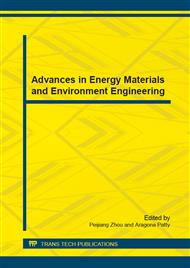p.94
p.99
p.103
p.113
p.117
p.121
p.125
p.132
p.136
Corrosion Behavior of Conducting Polymer PANI in Simulating PEMFC Conditions
Abstract:
Polyaniline (PANI) polymer coating was electrochemically synthetised by cyclic voltammetry (CV) method on stainless steel bipolar plates of proton exchange membrane fuel cell (PEMFC). Structure and morphology of PANI polymer coating were characterized by means of fourier transform infrared reflection (FTIR) spectrum and scanning electron microscopy (SEM). The corrosion behavior of the coating was evaluated by polarization curve and electrochemical impedance spectroscopy (EIS) in the medium of 1M H2SO4 and 2ppM NaF at 70°C to simulate the corrosive condition of PEMFC. It was found that the optimal conditions for PANI polymer coating synthesis could be 10-15 circles when the voltage ranged from-1.2V to +1.2V(Vs.SCE) with a scan rate of 50 mV/s. SEM observation results indicated that the polymer coating presented with uniform and dense feature. FTIR results illustrated that the coating were composed of PANI. Corrosion current densities of 316L SS and PANI-coated steel were 10-5 and 10-6 A/cm2 respectively. Corrosion potential of the coated SS shifted towards more positive values compared to the uncoated plate. EIS results indicated that the radius of the capacity impedance for PANI increased obviously.
Info:
Periodical:
Pages:
117-120
Citation:
Online since:
December 2014
Authors:
Keywords:
Price:
Сopyright:
© 2015 Trans Tech Publications Ltd. All Rights Reserved
Share:
Citation:


